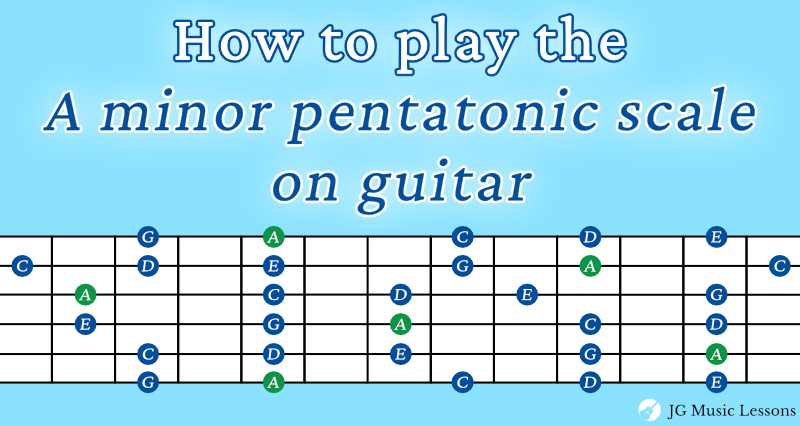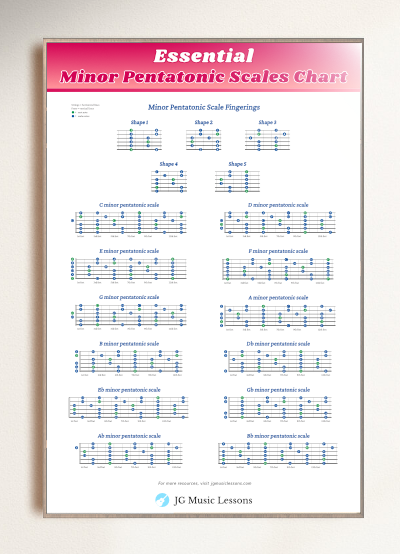In this lesson, we’ll break down how to play the A minor pentatonic scale on guitar by learning the five essential scale shapes across the fretboard. We’ll also dive into the music theory behind it, so you can understand how the scale works and apply it more effectively.
The pentatonic scale is a versatile five-note scale that serves as a foundation for melodic improvisation, helping you craft expressive and tasteful solos. If you haven’t yet explored the difference between major and minor pentatonic scales, be sure to check out the lesson here.
Grab your guitar, and let’s get started!
* Free for Pro Members
Minor pentatonic scale formula
If you already know the minor scale, learning the minor pentatonic scale is very simple. The minor pentatonic scale is made up of these 5 notes which come from the minor scale: the 1st, flat 3rd, 4th, 5th, and flat 7th scale degrees.
For example, the A minor pentatonic scale has the notes A, C, D, E, and G. This is essentially the A minor scale without the 2nd and 6th scale degree.
You can also create the scale using a whole and half step formula between each note. The minor pentatonic scale formula would be 1.5 whole steps, whole, whole, 1.5 whole steps, and a whole step. See the example below.

Or, you think of the notes in the scale in terms of intervals related to the root note. The intervals in the minor pentatonic scale are: unison (with the root note), minor 3rd, perfect 4th, perfect 5th, and minor 7th.
As a side note, the A minor pentatonic scale shares the same notes as the C Major pentatonic scale.
Now that we covered the music theory, let’s start learning the 5 scale shapes throughout the guitar fretboard.
5 A minor pentatonic scale shapes on guitar
This section covers the A minor pentatonic scale shapes throughout the guitar fretboard. Each shape includes music notation with guitar tabs to show you what fingers to use when playing the scale.
How to read the scale charts
For the charts below:
- The left side of the charts shows you the scale notes and the right side shows you the suggested fingering.
- The lowest horizontal line represents the thickest string (Low E) and the top horizontal line represents the thinnest string (high E).
- The green circles represent the root note of the scale and the blue notes are every scale note in between.
- Circles to the left of a chart represent open strings.
If needed, check this link for more on how to read guitar notation symbols.
Scale shape 1

For the notation below, the numbers above the notes suggest what fingers to use for your fretting hand.

Scale shape 2


Scale shape 3


Scale shape 4


Scale shape 5


* Free for Pro Members
Connecting A minor pentatonic scale shapes
Finally, here is what the A minor pentatonic scale looks like across the entire fretboard if we connect all the shapes.

3 tips for memorizing the minor pentatonic scale shapes
Here are 3 quick tips to help you memorize the 5 minor pentatonic scale shapes.
1. Master one shape at a time
The way I recommend learning and memorizing any scale is to start with one shape that feels most comfortable for you. Try to really get the shape under your fingers to the point where you don’t have to look at the chart. Use the first shape you master as a guide to learn the other scale shapes around it.
2. Look for repeating fingering patterns
Look for patterns such as what strings repeat the same fingering within a shape.
Tip: The notes on the first and sixth string will always be the same.
For example, in shape 3 we see that the 1st, 2nd, and 6th string follow a 1 and 4 finger pattern. The 3rd, 4th, and 5th string follow a 1 and 3 finger pattern. Knowing where note patterns repeat will help you build a mental map of a scale shape.
3. Connect shapes around the ones you learned
After learning one of the scale shapes well, either learn the shape that comes before or after it to see how the notes connect on the fretboard. Again, try to master one shape at a time and make sure you can play it without looking at the chart. This will make the process more approachable by breaking it down into smaller sections before moving on to the next shape.
Backing Track 🎶
Practice the A minor pentatonic scale by playing along with the backing track below.
🎶 Get the Echo in Blue track here!
Wrapping up
We’ve covered the five essential scale shapes for playing the A minor pentatonic scale. If you’re used to playing in just one position, stepping outside your comfort zone might feel challenging—but mastering these shapes will open up the fretboard and expand your playing!
Once you’re comfortable, try applying these shapes to different root notes to play the pentatonic scale in various keys.
If you enjoyed this lesson, you might also like our guide on how to play the blues scale. And to take your skills even further, check out this lesson on how to practice scales on guitar.
📘 Get the free guitar practice guide here!
Best,
JG Music Lessons
📙 Kickstart your guitar playing with our step by step guide: Guitar Essentials.
🎸 Looking for a travel or half-sized guitar? See this one.
🛠 See our other music recommendations.
🤝 Support the site to help us to create better content for you!
Level up with the FREE guitar practice guide and effectively improve your playing! 🎸
Get it sent to your email!




